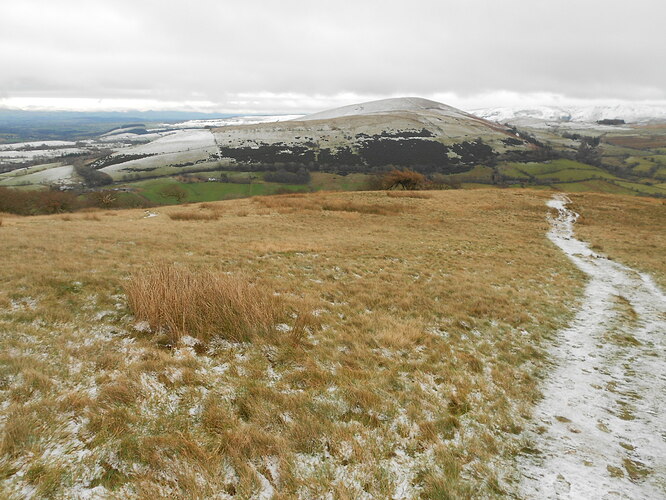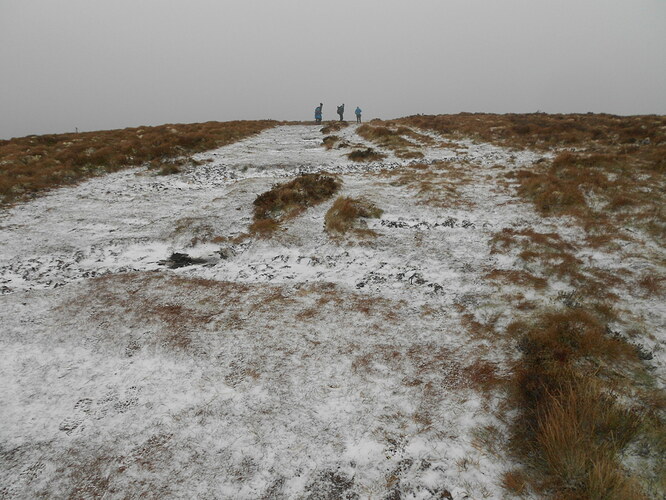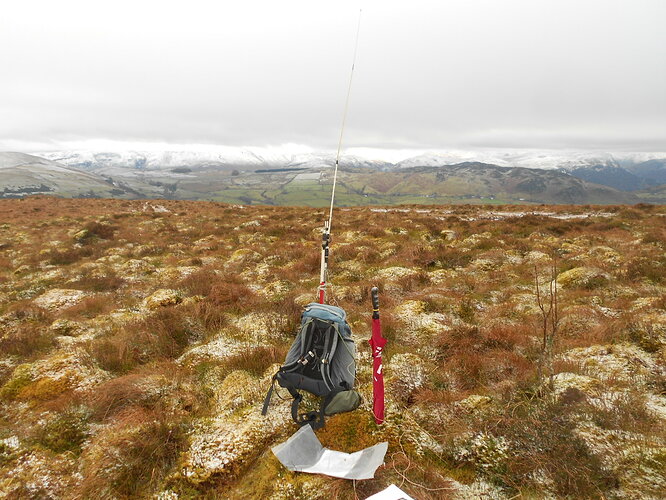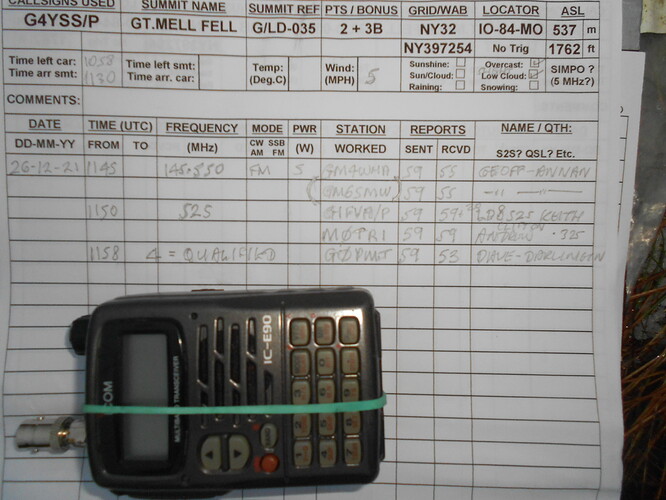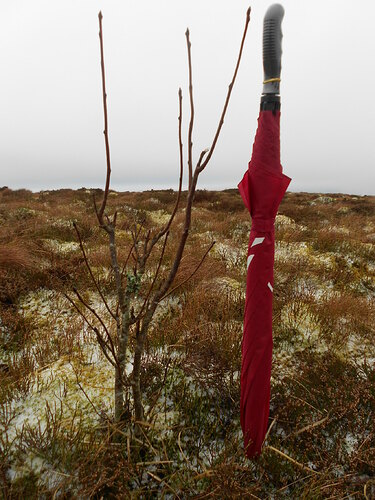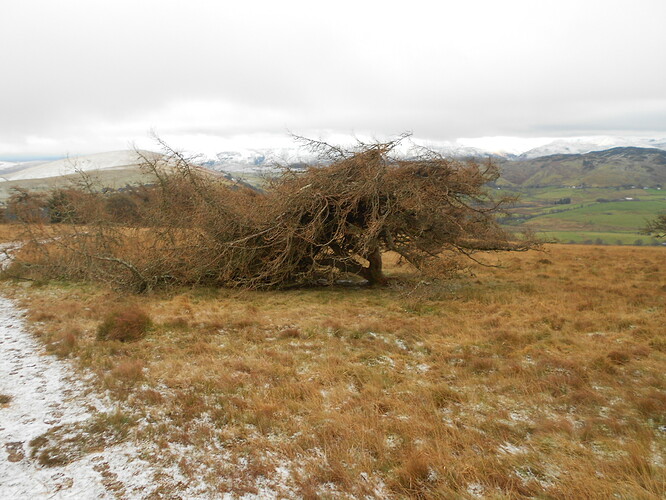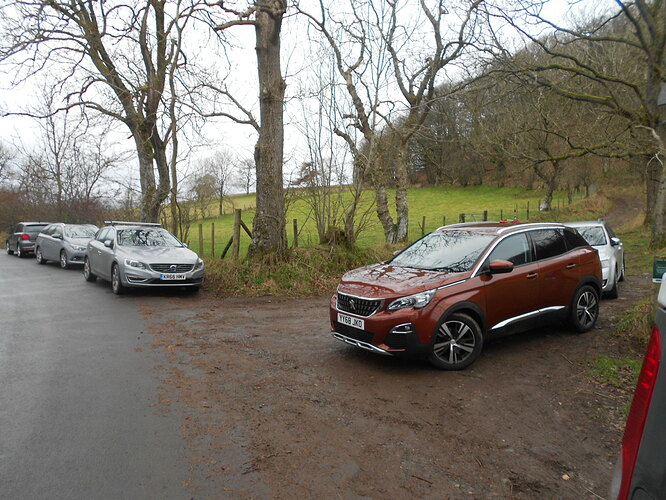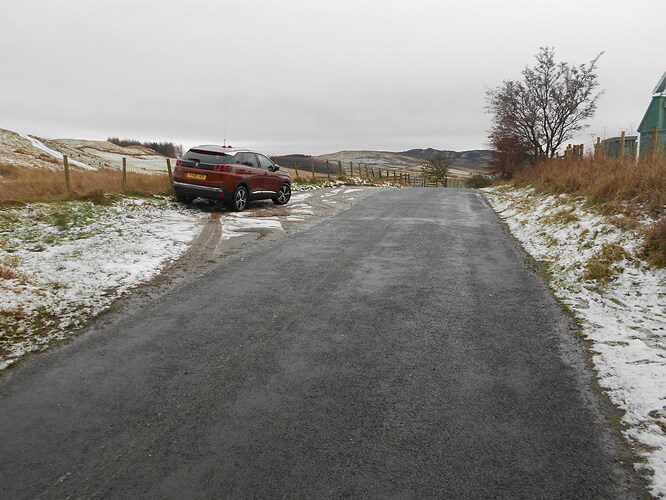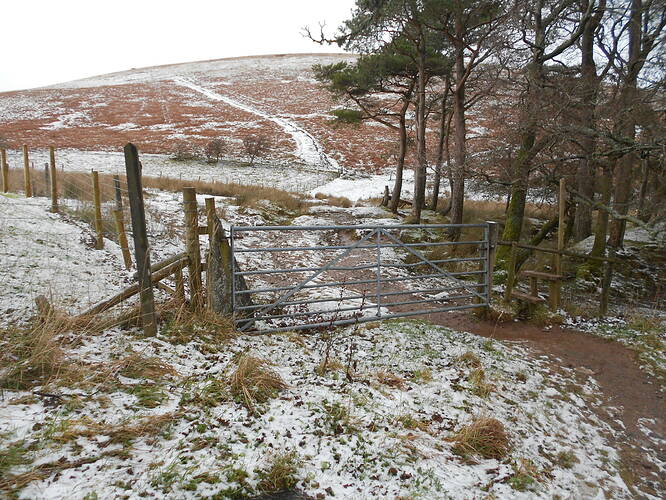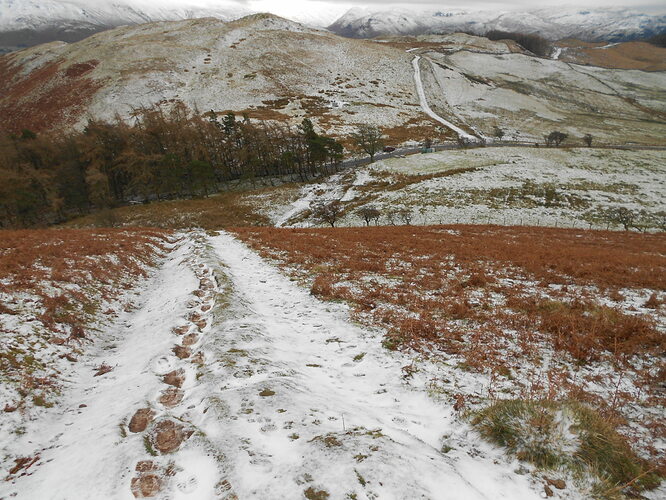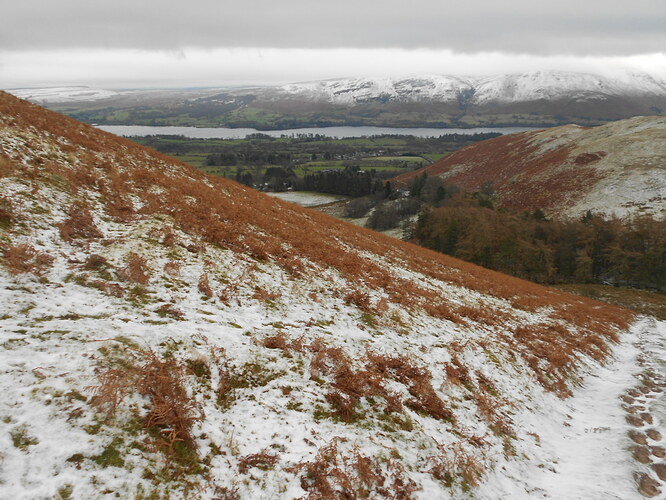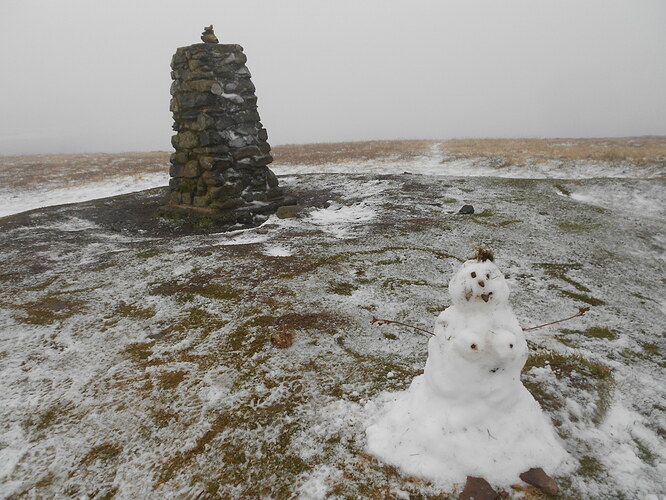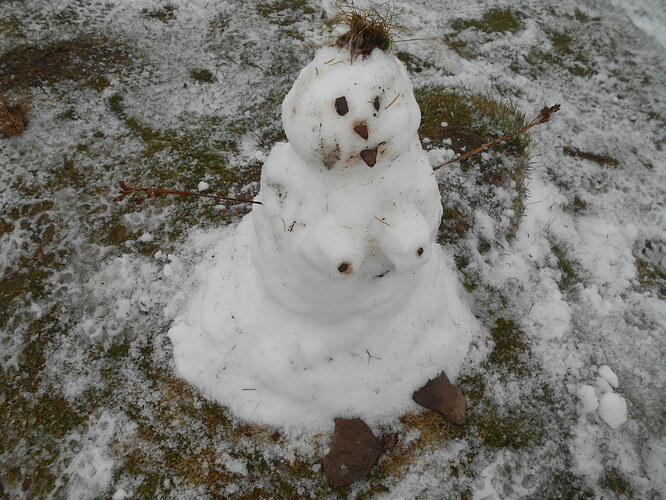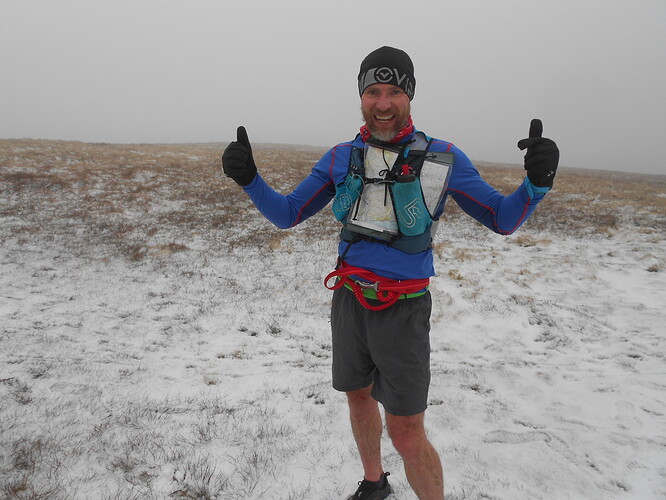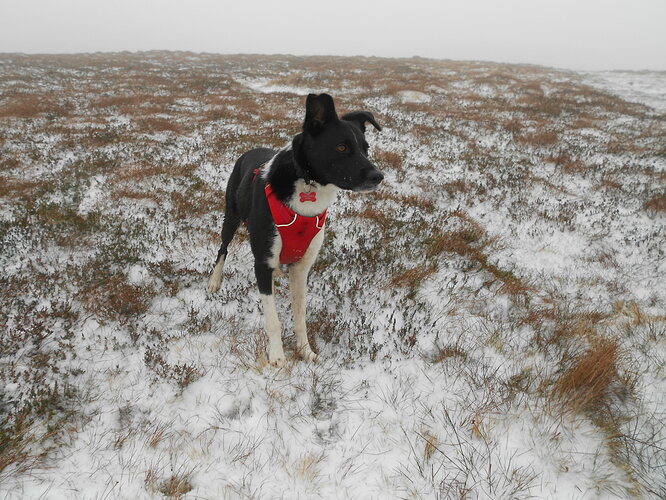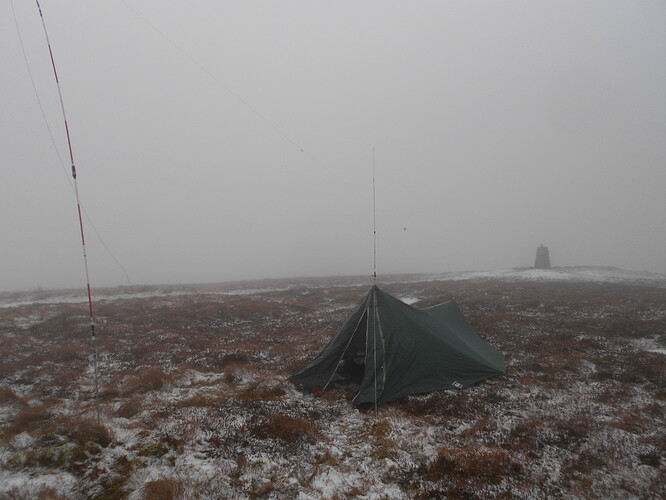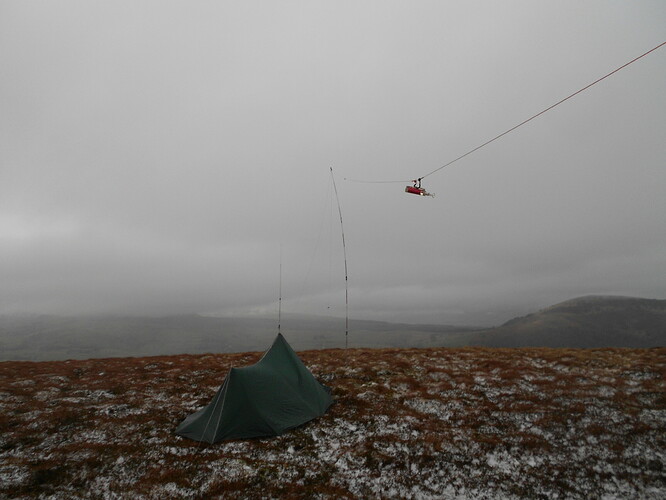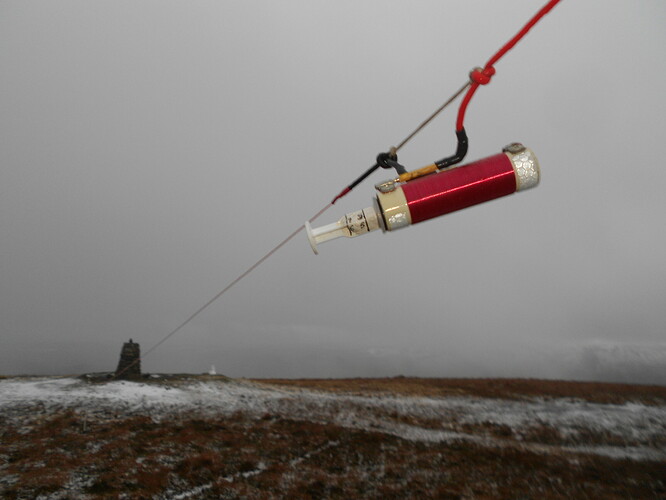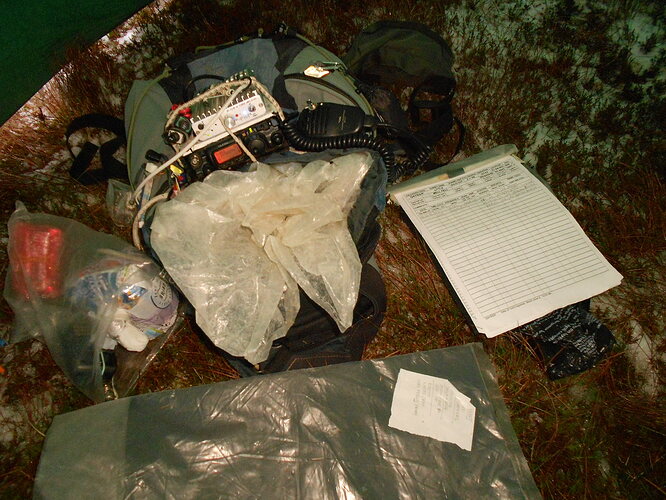G4YSS: Activation of LD35 & LD37, Mell Fells on 26-12-21
Issue-2 (M7KAZ Corrected)
Please report further errors
BOXING DAY Activations:
G/LD-035 Gt.Mell Fell on 2m-FM QRP, 26th December 2021
G/LD-037 Little Mell Fell on 160-80-20 QRO & 2m-FM QRP
G4YSS/P Unaccompanied
All times UTC
RADIO EQUIPMENT:
FT817ND HF/VHF/UHF 5W Transceiver without internal batteries
MX-P50M, 50 Watt HF Linear Amplifier, 80 thru’ 10m (160m)
Link dipole for 80-60-40-(30)-20m
Adjustable 160m loading coils for insertion at the 40m break points
Four section, 5m CFC mast with 1m end sticks
5Ah Li-Po Battery
2.2Ah reserve (not used)
(All above equipment was taken to both summits)
VHF:
IC-E90 4-Band/ 5W H/H Tcvr
Vertical J-Pole for 2m-FM
Other Equipment:
Garmin GEKO 301 GPS
Umbrella (LD35 only)
Viper-2 ridge flysheet, poles & pegs (LD37 only)
QRO Pack-weight: 10 kg (22 pounds) including 0.25 litres fluids (not used)
INTRODUCTION:
This was the third and final day of a 4-night stay at the Derwentwater Hotel with my XYL. Fairfield G/LD-007 and Seat Sandal G/LD-022 were activated on Christmas Eve (see separate report) and Christmas Day was spent at the hotel.
A plan for Boxing Day gradually emerged as Christmas unfolded. This was to activate Dale Head and Robinson, LD20 and LD21. As time went by the weather forecast began to potentially ruin the show. A change was made to put on just Dale Head in the afternoon but when overnight snow was predicted and duly arrived, even the reduced plan was cancelled. The main reason for this was vehicular access to the Buttermere valley. A safer but less ambitious option replaced the original one and the targets became the pair of 2-point Mell Fells.
In fact my fears about road conditions were confirmed at the evening meal later that day. The couple on the next table had tried to get to Buttermere and found the road closed just after Honister slate mine, which justified the change. As so often happens in SOTA, the weather gets the final word.
EXECUTION:
First an alert for the Mell Fells was posted on Sotawatch and then I hung around for a while to see what the weather might do. The drive along the A66 east from Portinscale to the parking place for Great Mell Fell at NY 4073 2469, took 22 minutes. I can’t remember seeing more than one car parked there in the past but today, a popular time for post-Christmas turkey exercise, there were three when I arrived and eight after the activation. Fortunately where the track leaves the road, there is just enough space to park this number of vehicles without causing an obstruction.
Route – LD35:
I left the car at 10:58 and proceeded WSW up the track for 250m, turning right onto a lesser track at a stile NY 4053 2455. This is the second stile which goes off the track to the right. I wouldn’t recommend taking the first one which is perhaps more obvious as it leads onto a well trodden path. After coming back that way in the early afternoon, I can testify that it’s very wet and muddy on the lower reaches.
You continue to follow the path via NY 4035 2456 and NW to NY 4025 2466 where it swings steeply NE to NY 4032 2482 and then NW to a junction at NY 4012 2496. (It’s worth making a mental note to take the right fork here on the way down). The path is quite easy to follow as it passes through wind-tortured trees around NY 3985 2523 to the small summit cairn at NY 3968 2537.
The ascent took a little over half an hour and the summit was shrouded in thin low-cloud as I arrived. This lifted occasionally but then kept returning.
Apart from one or two in Madeira, this is the only SOTA summit that I have been on with a tree in the activation area; one wind-blown, bent-over specimen at the edge of the AZ. Activating in the shelter of the tree is fine for HF but today I had to be at the top for the intended activation which would hopefully be VHF only. Setting up was quickly done as there was soft tussock grass to stick the mast in. Doing my best to save time, I didn’t even bother to detach the latter from the rucksack.
It may sound trite but LD35 was not the ‘main act’ of the day. That would be LD37 later where I planned to be ‘giving it the works’ so I was looking for a quick and easy VHF only session here. As many have experienced in the past, neither of the Mell Fells is a guaranteed qualification with VHF but I was hoping that it being Boxing Day, the HF gear could remain in the rucksack. Now a coat against the light breeze and a goodly slice of luck were the things required.
GREAT MELL FELL, G/LD-035, 537m, 2pts, 11:31 to 12:17. 0 deg C. 5 mph wind. Low-cloud. Vodafone coverage. (IO84MO, WAB: NY32, No Trig).
145.550 FM - 5 QSO’s:
Geoff GM4WHA must have seen my alert. He came straight back to the first CQ with a 59/ 55 exchange and furthermore put a spot on for me. He wasn’t stopping there with his help either and I worked him as GM6SMW just in case. I wouldn’t have entered it as the critical contact however, as there was always HF to fall back on.
Geoff understood and probably shared my fears about too few QSO’s on VHF from this summit but after scanning the band for me he served up a gem in the form of a potential S2S. This was Keith G1FVA/P literally just arrived across the A66 on G/LD-008 Blencathra, less than 5 miles away. Reports were excellent at 59 plus 20dB both ways and a strong wind could be heard blowing into Keith’s microphone. How lucky we were with the timing of that contact. Geoff was thanked for his help but before going QRT he put me onto a QSO on 145.325 ‘just in case.’
In fact breaking in between two chaps having a relaxed pre-lunch chat on Boxing Day wasn’t required after I worked two more stations. CQ’s were answered by M0TRI Andrew in Clifton, near Penrith and G0PMJ Dave in Darlington, who I’d worked on Christmas Eve. Further CQ’s on .500 and .550 went unanswered but Great Mell Fell was now properly qualified without HF.
Descent of LD35:
Just off the summit I met two people coming up with their dogs and we stopped to chat. After that ‘curiosity killed the cat.’ Retracing my steps back to the path junction at NY 4012 2496 I foolishly as it turned out, took the left fork. OK at first, the path wound around as far as NY 4055 2506 and NY 4061 2502, steepening as it went. By the time I’d reached NY 4067 2485 regrets had set in. At these lower reaches the path was wet, slippery and boggy. Furthermore it was no less a ‘round the houses’ route than the better ascent path. I won’t ever be using that route again, which leads down to that first stile mentioned earlier. Time at the car was 12:49.
Drive for LD37:
Driving round to The Hause for Little Mell Fell takes under 5 minutes and ascent of Little Mell commenced at 13:05.
Route LD37:
Park in the layby at NY 4234 2353. This short route has four sections:
- Cross the road and go over stile-1 NY 4237 2357, to stile-2 (or thro’ gate - often open)
- Climb steeply straight up to join a transverse path where you turn left at NY 4234 2371
- Go along here for a short distance to turn right at NY 4226 2380
- Follow path which goes straight up to the trig at NY 4233 2402
Immediately after climbing the stile by the road a messy wet reed bed needs crossing but it wasn’t as bad today as I remember it. Higher up, the path had a thin covering of snow. The ascent used to take me 11 minutes but today it took 16.
Someone had made a miniature snowman, or more accurately a snow woman near the trig. A young man ran up the hill with his dog. He was doing several summits today and asked about a direct route to Great Mell Fell which was invisible in the fog.
LITTLE MELL FELL, G/LD-037, 505m, 2 pts, 13:20 to 16:56. 0 deg C and rising. 3 mph wind. Low-cloud. Rain later. Dark at the end & the descent. (IO84NO, WAB: NY42 Trig: TP4447)
Lacking a steep drop-off in any direction, there is no shelter on the top of this summit apart from small patches of reeds and a depression in the ground next to the trig that tends to be wet. As mentioned earlier, there is a gnarled and deformed tree at the edge of the AZ which can be useful for HF. None of this was a consideration today as I had the tent flysheet but then I discovered that I’d forgotten a groundsheet. The dipole and mast went up easily as the ground was not frozen. In preparation for later on, the next job was to temporarily insert the Top Band loading coils and adjust them for resonance.
145.550 FM - 4 QSO’s:
I set the 5 Watt IC-E90 up with the J-pole atop the front tent pole. Kneeling uncomfortably on the tiny map case next to the tent door, I put out a CQ on 145.500 at 13:54. Once again Geoff GM4WHA answered from Annan, immediately the PTT was released. We exchanged at 59/ 55 as per LD35 in the morning and Geoff put a spot on for me.
The first responder to Geoff’s spot and someone else I’d worked in the morning, was M0TRI Andrew at Clifton. After swapping 59’s, he offered to persuade his XYL to work me. I hoped he wouldn’t actually disturb Kaz as she was downstairs watching The Sound of Music but a little later she came on the air as M7KAZ. The reports were 59 again and I thanked Kaz and Andrew for taking the trouble.
In between logging Andrew and Kaz, I worked Nigel M0MQV at Roadhead near Carlisle, 56/ 57. Nigel mentioned that like Andrew his ‘other half’ was licenced. After early competition for the one rig, he explained how they now managed to work HF from two separate shacks in the same house, at the same time albeit on different bands. This is when I learnt about something called a ‘Dune filter.’ This is an expensive single HF band BPF made by DX Engineering in the USA and it has a very high spec. As Nigel explained, ‘A very aggressive band edge slope.’ Every day’s a school day, as they say.
14.061 CW - 15 QSO’s:
A self spot preceded this session and it was efficient in creating quite a bit of interest with several calling at once. First in was OE6GND Gerhard with 599 both ways. Hearing Guru’s familiar callsign EA2IF, I worked him next giving and getting back the maximum. Settling into a routine after the initial shock of no CW since September, I proceeded to log the following callsigns:
S56RPJ Janko; HB9AGH Ambrosi; OK1DSA Roman; OH3GZ Jukka; EA4JM Juan; EA2DDG Jose; M0MQV Nigel - worked earlier on 2m-FM; HA8RJ Attila ; SV3IEG Dinos; OM1LA Josef; OM1ALT Michal and F/DD6DO Stephan. There was QSB on the band. Both outgoing and incoming reports were in the range 559 to 599. Power was 50W for the first eight QSO’s and 30W for the remainder.
3.780 SSB - 11 QSO’s:
I checked 3.760 and 7.160 but neither frequency featured any WAB activity. Another self spot got the ball rolling on 3.780 and I was quickly found by G4YBU - Tim in Epsom. Tim wasn’t hearing me too well hence the 55/ 33 exchange. Next came GM4ZMK Richard in Glasgow 58/ 57, then the familiar callsign of G4IPB – Paul in Teesdale with 59 both ways.
I reminded Paul about Top Band along with the next few callers starting with GI0AZA and GI0AZB - Esther and Ian (59’s). Next to call: G8VNW Nick in Wharfedale 59/ 58 and G6NHW Pete in Birmingham 59/ 44.
Turning the page of the log I heard GM4WHA call me. Geoff was 57 but he was only hearing me 33. It was pointless reminding Geoff about 160m as we’d already tried it after our 2m QSO. Neither of us heard a thing but to be fair Geoff didn’t have a remotely proper aerial and what he did have couldn’t be tuned up by the rig’s internal ATU.
The next CQ brought in a big signal from Ireland in the form of EI9CUB who gave his name as Patsy with QTH ‘70 miles North of Dublin.’ Going by QRZ.com, Patsy was in Coothill, County Cavan. He asked for my working conditions and marvelled at the signal, calling it, ‘Unreal for a /P setup’ but I knew it couldn’t be my aerial doing the work. He was using something he described as a ‘double bazooka’ which sounds like a lot of wire to me and the skip distance must have been absolutely optimal for the time and frequency.
After this armchair copy I worked the final two 80m stations: G6ZBV/M Adrian in Bangor, not a big signal as can be expected from a mobile whip but nevertheless 100% readable with 55 both ways. I used to do a lot of mobile HF working, making all my own whip antennas so it’s always a pleasure to work a /M on 80m.
Finally in came another familiar op in the form of Simon G4TJC - MG SOTA activator from Glossop in Derbyshire with a 58/ 45 exchange.
Power was 30W for this session which spanned 25 minutes to 15:35. I ended with: ‘Thanks to all stations worked – 160m in ten minutes!’ Then I went out into the fog to insert the pre-tuned Top Band coils.
1.832 CW - 4 QSO’s:
This was what I’d really come here for but at 15:45, was it yet dark enough for 160m to carry over any respectable distance? I thought not but was soon to be proved wrong.
Power was set back up to the maximum available 50 Watts and a self-spot sent out. I tried to make myself as comfortable as possible on the tiny sit-mat/ map case while leaning not too forcefully on the front tent pole. The rest of the floor area was just grass and short heather mixed with snow.
A few CQ’s later I was called by F6CEL no less! Ghis in Pignicourt lives about 20km north of Reims. We exchanged with 579/ 559 and a few added ‘FB’s.’ What a great start and in fact this turned out to be the furthest 160m contact of the day.
Next I heard Esther GI0AZA calling but she was having great difficulty reading the return signal. However after a few repeats the QSO was good with an exchange of 579 (generous) and 339 coming back. After a short while, Ian GI0AZB followed with the same pattern of QSO and reports as Esther.
In between I worked G4DJX Alan in St.Albans. Alan’s signal was strong at 599 and I got back 589. Another op whom I suspected, had built himself a good 160m station.
1.846 SSB - 2 QSO’s:
At 16:10 I elected to QSY to the SSB frequency, which was not completely quiet. I tried my old original freq of 1.843 but there again was the penetrating data noise that had hounded me off there in the first place. Returning to 1846 and calling CQ got me an easy contact with Paul G4IPB. Reports were 58/ 57 so no words were missed and Paul spotted me.
Last but not least in SSB was ON7ZM – Jean Pierre in Goesnes, Belgium. I gave him a 58 with 44 coming back. Good contact and another country worked.
I noticed that Phil G0UUU was spotting my QSY’s between CW and SSB, which was very helpful, so he must have been listening on the Nantwich receiver again.
1.832 CW - 1 QSO:
After the SSB session, I returned to 1.832-CW, logging EI6FR as the last contact of the day with 589/ 449 reports. In the final part of this QSO the rig cut out indicating the end of the 5Ah battery. I could have swapped it for the 2.2Ah reserve but instead dropped the power to 30W. However when two more CQ’s went unanswered, I deemed it time to pack up.
Packing up & Descent:
With two stations, a dipole, a VHF vertical and a flysheet to pack up in darkness, I would need to hurry but outside the temperature had risen above freezing and it had been raining for at least half an hour. ‘Great’ thought I. Now I have to deal with a sodden tent flysheet and get wet while I’m doing it. Fortunately I got away with the latter as the rain conveniently faded away after a short while.
The dripping tent was roughly bundled up and bungied to the back of the rucksack for the descent with the result that water ran down and soaked my lower back (for want of a better word). This transferred to the car seat on the way to the hotel, the wet patch making it look like I’d had a physiological accident. Fortunately the seat dried out before my XYL saw it or tried to go shopping in her car.
STATS:
QSO’s LD35 (GMF):
2m FM: 5
QSO’s LD37 (LMF):
2m FM: 4
20m CW: 15
80m SSB: 11
160m CW: 5
160m SSB: 2
TOTAL QSO’s for Day: 42
SOTA Points: 10 (inc 6 bonus)
Ascent & Distance:
LD35: 279m (915ft) ascent / 2 x 1.8 km (2.2 miles) walked
LD37: 125m (410) ascent / 2 x 0.7 km (0.9 miles) walked
TOTAL for Day: 404m (1,325ft) ascent / 2.5km (1.6 miles)
2-DAY STATS (G/LD7+LD22 & LD35+LD37):
Total ascent & distance: 1,199m (3,934ft)/ 10.5km (6.6 miles)
SOTA Points: 30 (inc 12 bonus)
Distance Driven Home to Home: 336 miles
Observations:
The target hills for today had to be changed due to the weather but from a radio viewpoint the original plan of 2m-FM in the morning and HF QRO with 160m in the afternoon didn’t change.
The substitution of LD35 & 37 for LD20 and 21 was justified. This is what the Keswick Examiner had to say about it on 26th December:
“Drivers are urged to avoid Honister Pass following a one vehicle collision. Cumbria police said the incident occurred due to weather conditions and the road is blocked. The vehicle will be recovered once the weather conditions improve.”
They also mentioned that the A66 was closed between Scotch Corner and Brough due to snowfall. Fortunately there was no snow at the lower levels and none of this affected our plans as we went home a different way on the 27th, calling to see a friend at Sedbergh.
LD35 Great Mell Fell in the morning was just a side show, merely a way of filling the day and getting five extra points. I was very fortunate to qualify it without recourse to time consuming HF deployment, though I had that with me just in case. The activation was greatly helped through the efforts of Geoff GM4WHA.
Whether it be LD20 Dale Head or it’s replacement LD37 Little Mell Fell, the afternoon activation was always going to be the main act. Either way the plan was to stay until it got dark for some Top Band action. Though it can be quite hard work, that plan came to fruition with seven stations logged on 160m plus the bonus of 20m and 80m contacts after the start on 2m.
I was pleasantly surprised to work France and Belgium on 160m as well as some of the regular UK enthusiasts. He and I worked OK on 80m but Nick G8VNW didn’t make it through on 160m. There were other callsigns missing from the log such as Phil G4OBK, Brian G8ADD and Dave G3RDQ to name just three That could be because I failed to give enough warning.
I was surprised not to find a WAB net running on Boxing Day but they might have come and gone by the time I looked for them. NY42 and TP4447 went to waste and they would have improved my average QSO rate by their highly organised style of working.
20m CW put a nice few contacts in the log though no DX was worked. There was deep QSB at times which confused things a little. Apart from the two QSO’s on Top Band, 80m was the SSB offering and that band seemed to be in good condition for stations around the UK.
VHF qualification of either of these two low hills can never be taken for granted but with sterling help from Geoff GM4WHA on LD35, I managed to get 4 QSO’s from both. Probably the Christmas holiday ensured there were more chasers available. I was sorry not to log G0TDM on 2m. John has been a mainstay of LD-VHF activators for many years. I wish him well and I hope things improve for him in 2022.
The weather wasn’t as inclement as the forecast led us to believe but the overnight snowfall was great enough to block some roads. Though low-cloud played its part there was no precipitation until late in the day and it wasn’t desperately cold or overly windy either.
I met a few happy people on the way, especially on Great Mell in the morning and a few nice dogs too. Apart from poor VHF coverage, these two were easy options but nevertheless very enjoyable this time around.
THANKS:
To all stations worked and today’s spotters GM4WHA; G4TJC; G4IPB and G0UUU (plus any I’ve missed). Also thanks for use of the SOTA spotter. To Geoff GM4WHA for his help with the LD35 VHF only activation. To the Derwentwater Hotel for a pleasant Christmas stay and a great base for SOTA. Thanks to my XYL for her tolerance and for the use of her car. I promise to clean my mud off your mats.
73, John G4YSS
Photos: 2-3-13-10-16-19-26-27-28-30-34-36-37-40-41-43-51-52-53
Above: On the way up Great Mell Fell LD35 in the morning.
Little Mell Fell LD37 in the distance.
Above: Higher up the Great Mell Fell path
Above: Activation of G/LD-035 Great Mell Fell on 2m-FM only
Above: Great Mell Fell. Log and ICOM IC-E90, 5W, 4-Band VHF H/H
Above: A summit tree for future activators to sit under?
Above: The effect of regular high winds
Above: Great Mell Fell LD35 parking place; busier than normal today
Above: Layby for Little Mell Fell LD37
Above: LD37 L.Mell. Stile from the road, reed bed/ muddy path.
Above: Looking back to the road and car. Steps made by thousands of feet.
Above: View of Ullswater from the path up L.Mell Fell
Above: G/LD-03 Little Mell Fell. Trig TP4447 with snow-woman
Above: The runner and his dog on a multi-summit round. Great Mell next.
Above: Activation of Little Mell Fell on 2-20-80-160m
Above: 80m link dipole loaded for 160m at the 40m break points
Above: Inside the flysheet. Great but lacking a groundsheet
